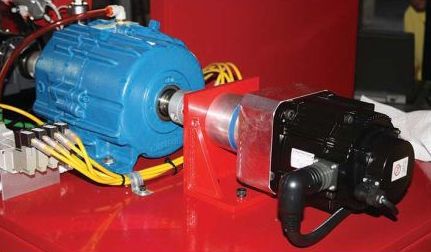When a major manufacturer of lacrosse stick equipment needed to test the durability of their lacrosse sticks in game-like settings, an oil shear clutch helped them to score big time. Automated Design Corporation developed an automated solution that was flexible enough to test multiple strike sites with consistent performance and repeatability, and mimic human interaction. In a real-world scenario, a human wielding a lacrosse stick that strikes a concrete post, for example, would stop driving the stick and let it rebound. In nature it happens automatically, but that same action is much more difficult to replicate in an automated environment. The desired action is achieved with the Force Control Clutch thanks to Oil Shear technology.
Automated Design used an oil shear clutch brake manufactured by Force Control Industries. A servo system was connected to input of the clutch-brake. This allows the customer to decide at what degree they want to release the clutch. The stick is driven into the anvil and the clutch is released at whatever degree the customer decides, at which point the stick is then in “free fall” mode, bouncing around within its arc until the clutch is re-engaged and the process repeats…all day long.
“The advantage of the Force Control clutch is that we wanted an accurate, repeatable, position and we get that with oil shear technology,” said Automated Design Project Manager Joe Bitsky.
Durability is also a major factor as the stick “is driven with high velocity (at top speeds of 130 MPH) into the anvil, and then grabbed with the clutch literally thousands of times a day. When the clutch is engaged, we need a very reliable system,” said Bitsky. “No matter how many times we engage the clutch, it is going to stay in a consistent position.”
This unique technology, which allows accuracy and repeatability in a high cycle count environment, provides data that allows the manufacturer to produce lacrosse sticks that withstand even the most brutal of crosschecks – allowing safer games at all levels of play.
Oil-shear technology also ensures the test stand can operate continuously, without adjustment. A film of transmission fluid circulates through the friction surfaces of the clutch stack. When the clutch is engaged that fluid gets compressed. Particles in the fluid transmit torque to the other side when they are in shear. This torque turns the stationary surface, bringing it up to the same speed as the moving surface. Because most of the work is done by fluid particles in shear, there is little wear in the short time it takes for the surfaces to actually meet or “lock up.” And when they do lock up, it is a “cushioned” engagement that reduces shock to the motor and extends its service life. Unlike dry clutches, the totally enclosed oil-shear clutch is impervious to external elements in wet, dusty, or dirty environments. In addition to transmitting torque, the fluid dissipates heat, thanks to a patented fluid recirculation system, and keeps all components lubricated. “The system has been operating for just over three years,” says Bitsky. “And we’ve never had a single call from the customer.” Bitsky estimates the company’s two lacrosse-testing machines have over a million cycles on them and continue to operate without incident. In fact, the versatile design and precise positioning and repeatability of the clutch/brake let the test stands be used for throw testing, part of the durability testing regimen for lacrosse balls. “When we’re not banging lacrosse sticks, we use the test stand for throw studies,” he says. “We want to be able to make it spin any way we want — and the clutch lets us do that.”

